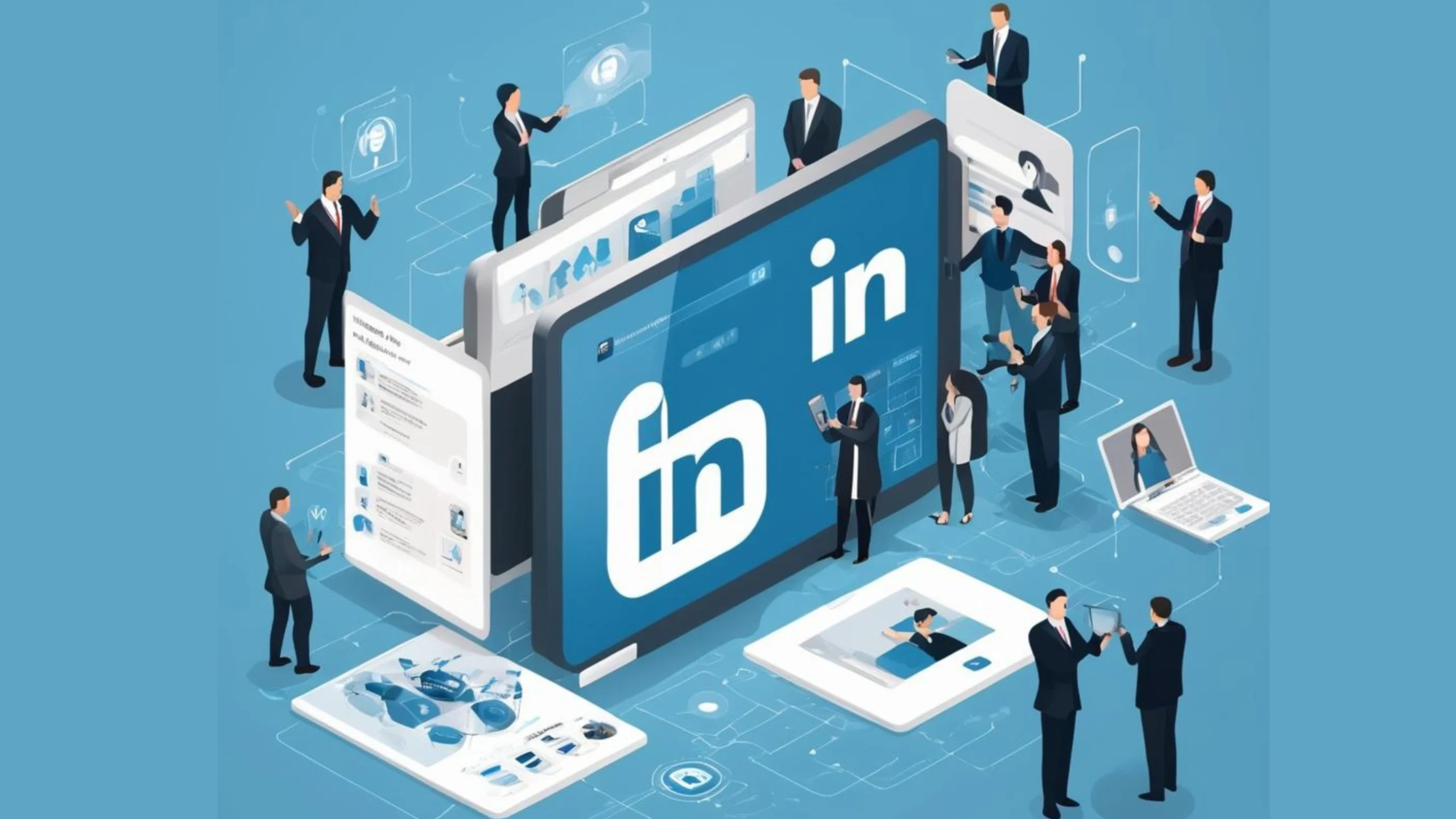Did you know that 80% of B2B leads are generated from LinkedIn? That’s right! If you’re not leveraging LinkedIn for your B2B marketing, then You’re missing out on a goldmine of opportunities.
LinkedIn allows you to tailor your profile to highlight your brand’s strengths, generate compelling content that captivates your audience, and use advanced targeting options to reach the right people at the right time. The opportunities for brand building and lead generation are unparalleled.
Get ready to unlock the full potential of the world’s largest professional network! In this comprehensive guide, we’ll walk you through the ins and outs of LinkedIn marketing, helping you transform your company’s presence and skyrocket your lead generation.
Optimizing Your Company’s LinkedIn Profile
In the digital era, a Company’s LinkedIn profile serves as its virtual storefront. Its optimization is essential for success.
Creating a compelling “About” section showcasing what makes your brand special and unique.
This section should provide a concise yet powerful exposition of your brand and why a LinkedIn prospect should choose your services above others. Telling a brief, compelling story about your brand that resonates with your target audience is not only essential but strategic.
Selecting the right profile and banner images to make a strong visual impact
A strong first impression can make your brand stand out and enhance brand recognition. Select your profile picture and banner image carefully. Remember that these visuals aren’t just for looks—they shape how people see your brand. These are the first handshakes with potential clients. Use clear, high-quality images and a well-designed banner image that matches your company’s style and values.
Incorporating relevant keywords throughout your profile
Incorporating relevant keywords throughout your profile is indispensable to improving searchability and visibility on LinkedIn’s platform. This process, known as semantic optimization, involves strategically placing industry-specific terms and phrases in your company description, key projects, and other sections. Keep your writing natural and easy to read. Avoid keyword stuffing; it can make your profile hard to understand and potentially violate LinkedIn’s guidelines. It would help if you wrote for people rather than search engines. Make sure your profile is both easy to find and interesting to read.
Highlighting essential products, services, and achievements to attract potential clients
Highlighting key products, services, and achievements can attract potential clients and demonstrate your company’s expertise. Use LinkedIn’s Featured section to showcase B2B case studies or key projects. This showcase acts as social proof, enhancing your credibility and encouraging LinkedIn prospects to interact more with your brand.
Developing a Winning Content Strategy
Understanding the content type that resonates with B2B audiences on LinkedIn
This part is fundamental to a successful content strategy. B2B decision-makers often seek thought leadership, industry insights, and solutions to complex business challenges. For instance, analysis of market trends can highlight thought leadership. In contrast, case studies can address complex challenges and give answers in B2B case studies. Content that addresses these needs to a company’s expertise can significantly enhance engagement and lead generation.
Creating a content calendar to stay consistent and relevant
Creating a content calendar is essential to maintaining consistency and relevance in your LinkedIn marketing campaign. It will help you plan content themes, align with industry events, and balance content types. A well-structured content calendar is crucial for encouraging team collaboration. It helps maintain a consistent brand voice throughout all posts, keeping your brand message clear and consistent.
Leveraging LinkedIn’s native content formats (articles, posts, videos, documents)
LinkedIn offers a variety of native content formats, each with unique strengths. Posts are best for quick updates and interaction, but articles allow in-depth discussion. Videos can humanize your brand and explain complex concepts visually. At the same time, documents provide a platform for sharing detailed reports or presentations. If you want to boost the visibility and engagement of your post, then choose the proper content format. It can get more comments, views, likes, and shares. Boosts your brand on LinkedIn marketing and increase your influence within your industry.
Balancing Promotional Content with valuable, educational material to build trust
According to the 80/20 rule, 80% of your Content should be for the audience to educate and inform them, with only 20% being direct promotion. This helps establish your company as an industry expert and builds genuine connections.
Building and Engaging Your B2B Network.
Identifying and connecting with decision-makers in your target industries
Use the advanced search feature to identify people who fit your ideal customer profile. Personalize your connection requests with a brief statement. Highlighting common interests or potential collaboration increases the possibility of accepting your request and results in more relevant conversations.
Expand your reach and establish thought leadership using LinkedIn Groups.
LinkedIn Groups are a unique way to broaden your reach and build thought leadership. It will
- Position your brand as a knowledgeable and helpful resource within your niche.
- Actively participate in relevant industry groups.
- Share insights, answers to questions, and engage in discussions.
Develop relationships through implementing effective social selling techniques.
Social selling does not involve making direct sales pitches. It’s all about making genuine connections, sharing helpful Content, and engaging with prospects. By providing value and addressing problems, you can gain trust and establish yourself as the industry’s go-to solution provider. This strategy frequently results in more meaningful conversations and more possibilities for business.
Encouraging employee advocacy to amplify your company’s message
Develop a program that empowers employees to share company content, insights, and achievements on their profiles. This organic amplification extends your reach and lends authenticity to your brand message. Content shared by individuals frequently garners higher engagement than company posts alone.
Unlocking the Power of LinkedIn Advertising
LinkedIn’s advertising platform provides a suite of powerful options for B2B marketers.
Overview of LinkedIn’s advertising options
- Sponsored Content allows you to boost your organic posts for increased visibility.
- Message Ads enable you to communicate directly with prospects in their LinkedIn inboxes.
- Dynamic ads personalize ad content based on the viewer’s profile information, creating a more engaging experience.
Understand these options and their relative strengths for developing an effective advertising strategy.
LinkedIn’s powerful audience segmentation: game-changer for B2B advertising.
It maximizes the efficiency of your ad budget by targeting the most relevant decision-makers. This tool lets you target ads based on job title, company size, industry, and specific skills or interests.
Creating compelling ad copy and visuals that drive engagement and conversions
- A/B testing different ad elements can improve performance and refine your approach over time.
- Directly speaks to your target audience’s pain points and aspirations.
- Offer clear value propositions in your ads.
Utilize eye-catching visuals and concise, action-oriented copy to stand out in the LinkedIn feed.
Measuring and optimizing your ad performance for maximum ROI
LinkedIn’s analytics tools provide valuable insights, like click-through, engagement, and conversion rates. Regularly analyze these metrics and be ready to refine your ad strategy. Adjust targeting, creative elements, and bidding strategies based on trends and opportunities for improvement. And it is crucial for achieving maximum ROI.
Generating and Nurturing B2B Leads
Developing lead magnets tailored to your LinkedIn audience
With invaluable resources like white papers, e-books, or webinars, you should address specific pain points or offer unique insights relevant to your target market. The key is creating compelling Content for LinkedIn prospects to exchange contact information. It’s a very effective way to generate quality leads.
Implementing LinkedIn Lead Gen Forms to capture high-quality leads
These pre-filled forms increase conversion rates by streamlining the lead capture process. Customize these forms to gather the most relevant key information for your sales team. Balance data needs with users’ desire for quick submissions. These LinkedIn Lead Gen Forms capture high-quality leads within the platform.
Creating a seamless process for B2B lead nurturing and follow-up.
This process is essential for converting LinkedIn leads into customers. Develop a structured workflow with timely follow-ups, personalized content delivery, and strategic touchpoints. Utilize LinkedIn marketing automation tools to scale this process while maintaining a personalized approach for each lead.
Integrating LinkedIn with your CRM for efficient lead management
Integrating LinkedIn with your CRM system makes lead management easier. It gives a complete view of how prospects interact with your brand. This integration ensures smooth data transfer, so your sales team always has the latest information about each lead. It also facilitates more targeted follow-ups and personalized communication, increasing the likelihood of conversion.
Analyzing and Optimizing Your LinkedIn Performance
Key metrics to track for measuring LinkedIn marketing success
Focus on metrics like engagement, click-through rates, and conversion rates to see how your Content and campaigns are doing. Also, monitor follower growth to evaluate your brand’s overall performance on the platform.
Using LinkedIn Analytics to gain insights into your audience and content performance
Regularly analyze the valuable insights given by LinkedIn analytics to see
- What types of Content does your audience like best?
- Best times to post.
- And how you compare to industry standards.
Use this information to improve engagement and refine your content strategy.
A/B testing strategies for continuous improvement
Test content elements like headlines, visuals, and CTAs to identify what works best with your audience. Apply an A/B testing strategy to organic Content and paid advertising to optimize performance across all aspects of your LinkedIn presence. This is crucial for continuously improving your LinkedIn marketing efforts.
Adjusting your strategy based on data-driven insights
The key to long-term success on LinkedIn is;
- Adjust your strategy based on data insights.
- Regularly review your performance data.
- Be prepared to change your approach based on the results.
You might need to reallocate resources to high-performing content types, change your targeting strategy, or experiment with new formats. This will ensure that your LinkedIn marketing strategy stays effective in a constantly changing digital landscape.
Conclusion:
LinkedIn marketing is essential for B2B companies in 2024 and beyond. Optimize your profile, create engaging Content, and build meaningful connections—Leverage LinkedIn’s powerful advertising tools to generate high-quality leads and position your brand as an industry leader. Remember, consistency is key, and the B2B landscape is constantly evolving. Stay agile, keep learning, and watch your LinkedIn marketing efforts transform your business. Ready to take your B2B marketing to new heights? It’s time to put this guide into action and dominate LinkedIn!
For Further info: visit blogrily.com








